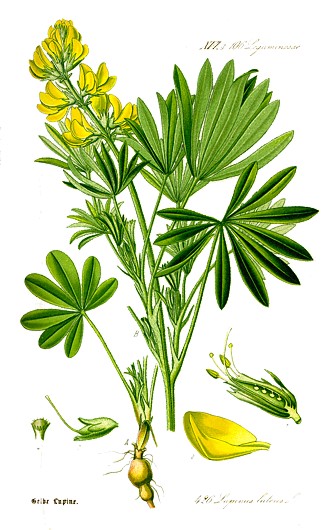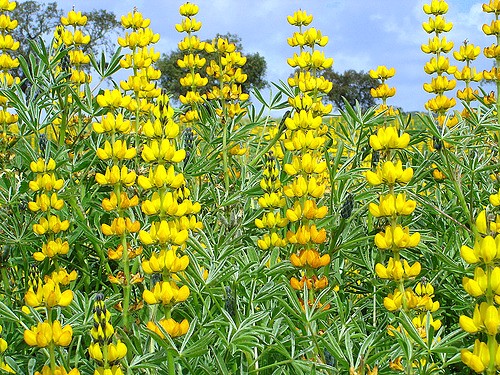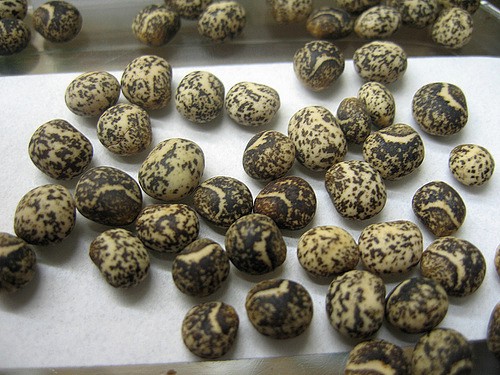Lessico
Lupino
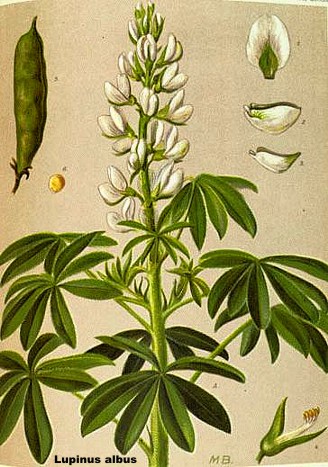
Il latino lupinus
è un aggettivo che significa del lupo, attinente al lupo, e lo troviamo
sostantivato già in Catone![]() (De agricultura). Come riferisce Alexandre de Théis nel suo Glossaire
de botanique (1810) la maggior parte dei glottologi, basandosi su Plinio
(De agricultura). Come riferisce Alexandre de Théis nel suo Glossaire
de botanique (1810) la maggior parte dei glottologi, basandosi su Plinio![]() ,
il quale afferma che il lupino ama la terra (xviii,133:
Terram amat terraque operiri non vult.), accosta il
lupino al lupo in quanto questa pianta ama la terra tanto come il lupo ama gli
animali, e se li divora. Altrettanto farebbe il lupino nei confronti della
terra.
,
il quale afferma che il lupino ama la terra (xviii,133:
Terram amat terraque operiri non vult.), accosta il
lupino al lupo in quanto questa pianta ama la terra tanto come il lupo ama gli
animali, e se li divora. Altrettanto farebbe il lupino nei confronti della
terra.
Ma, secondo
altri etimologisti, lupinus deriverebbe dal greco lýpë che
significa dolore, afflizione, pena, sofferenza, in quanto con la sua amarezza
dà un aspetto triste al volto di colui che lo mangia, citando Virgilio![]() che scrisse "tristisque lupini" (Georgiche I,75).
che scrisse "tristisque lupini" (Georgiche I,75).
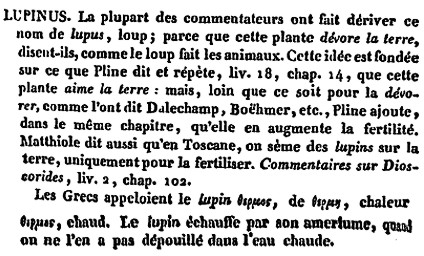
Il genere Lupinus comprende piante della famiglia Leguminose o Papilionacee con ca. 300 erbe in prevalenza americane. Fra quelle del bacino mediterraneo la più nota, coltivata fin dall'antichità, è Lupinus albus, annua o bienne, con foglie digitato-composte e fiori bianchi, in racemi allungati.
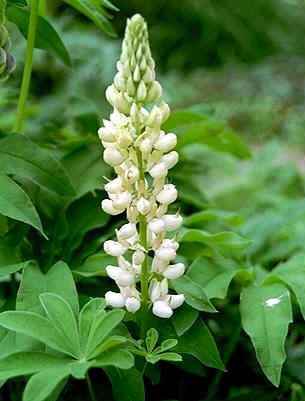
Lupinus albus
Il legume è vellutato, compresso, con semi arrotondati e appiattiti, che contengono principi amari e velenosi eliminabili mediante cottura o macerazione in acqua salata, dopo di che diventano commestibili e sono usati per l'alimentazione umana o degli animali.
Oltre che per i semi, i lupini sono coltivati come piante da sovescio.Alcune specie, molto decorative per le loro alte pannocchie di fiori rossi, azzurri, ecc., sono spesso coltivate nei giardini: per es. Lupinus polyphyllus.
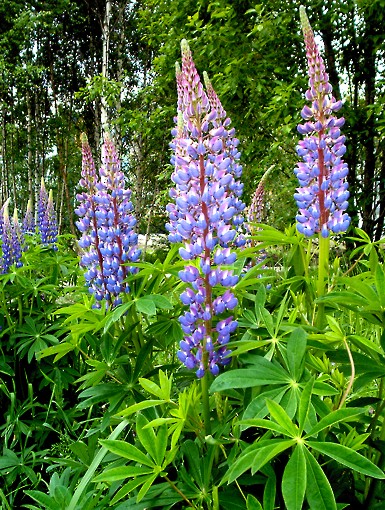
Lupinus polyphyllus

Lupinus polyphyllus
Lupinus angustifolius
Lupin, often spelled lupine in North America, is the common name for members of the genus Lupinus in the legume family (Fabaceae). The genus comprises between 200-600 species, with major centers of diversity in South America and western North America - subgen. Platycarpos) and subgen. Lupinus - in the Mediterranean region and Africa.
The species are mostly herbaceous perennial plants 0.3-1.5 m (1-5 ft) tall, but some are annual plants and a few are shrubs up to 3 m (10 ft) tall - see also bush lupin -, with one species (Lupinus jaimehintoniana, from the Mexican state of Oaxaca) a tree up to 8 m high with a trunk 20 cm (8 in) in diameter. They have a characteristic and easily recognised leaf shape, with soft green to grey-green leaves which in many species bear silvery hairs, often densely so. The leaf blades are usually palmately divided into 5–28 leaflets or reduced to a single leaflet in a few species of the southeastern United States. The flowers are produced in dense or open whorls on an erect spike, each flower 1-2 cm long, with a typical peaflower shape with an upper 'standard', two lateral 'wings' and two lower petals fused as a 'keel'. Due to the flower shape, several species are known as bluebonnets or quaker bonnets. The fruit is a pod containing several seeds.
Like most members of their family, lupins can fix nitrogen from the atmosphere into ammonia, fertilizing the soil for other plants. The genus Lupinus is nodulated by Bradyrhizobium soil bacteria. Some species have a long central tap roots or proteoid roots.
Lupins contain significant amounts of certain secondary compounds like isoflavones and toxic alkaloids, e.g. lupinine.
The yellow legume seeds of lupins, commonly called lupin beans, were quite popular with the Romans and they spread the cultivation of them throughout the Roman Empire; hence common names like lupini in Romance languages. Lupin beans are commonly sold in a salty solution in jars (like olives and pickles) and can be eaten with or without the skin. Lupins are also cultivated as forage and grain legumes.
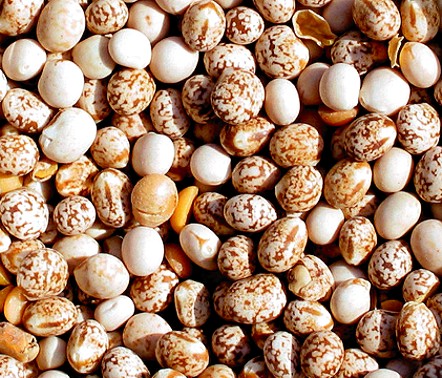
Today, lupini dishes are most commonly found in Mediterranean countries, especially in Portugal, Egypt, and Italy, and also in Brazil and in Spanish Harlem, where they are popularly consumed with beer. The Andean variety of this bean is from the Andean Lupin (tarwi, L. mutabilis) and was a widespread food in the Incan Empire. The Andean Lupin and the Mediterranean L. albus (White Lupin), L. angustifolius (Blue Lupin) and Lupinus hirsutus are also edible after soaking the seeds for some days in salted water. They are known as altramuz in Spain and Argentina. In Portuguese the lupin beans are known as tremoços, and in Antalya (Turkey) as tirmis. Lupins were also used by Native Americans in North America, e.g. the Yavapai people.
These lupins are referred to as sweet lupins because they contain smaller amounts of toxic alkaloids than the bitter lupin varieties. Newly bred variants of sweet lupins are grown extensively in Germany; they lack any bitter taste and require no soaking in salt solution. The seeds are used for different foods from vegan sausages to lupin-tofu or baking-enhancing lupin flour. Given that lupin seeds have the full range of essential amino acids and that they, contrary to soy, can be grown in more temperate to cool climates, lupins are becoming increasingly recognized as a cash crop alternative to soy.
Three
Mediterranean species of lupin, Blue Lupin, White Lupin and Yellow Lupin (L.
luteus![]() )
are widely cultivated for livestock and poultry feed. Both sweet and bitter
lupins in feed can cause livestock poisoning. Lupin poisoning is a nervous
syndrome caused by alkaloids in bitter lupins, similar to neurolathyrism.
Mycotoxic lupinosis is a disease caused by lupin material that is infected
with the fungus Diaporthe toxica; the fungus produces mycotoxins called
phomopsins, which cause liver damage. On 22 December 2006, the European
Commission submitted directive 2006/142/EC, which amends the EU foodstuff
allergen list to include "lupin and products thereof".
)
are widely cultivated for livestock and poultry feed. Both sweet and bitter
lupins in feed can cause livestock poisoning. Lupin poisoning is a nervous
syndrome caused by alkaloids in bitter lupins, similar to neurolathyrism.
Mycotoxic lupinosis is a disease caused by lupin material that is infected
with the fungus Diaporthe toxica; the fungus produces mycotoxins called
phomopsins, which cause liver damage. On 22 December 2006, the European
Commission submitted directive 2006/142/EC, which amends the EU foodstuff
allergen list to include "lupin and products thereof".
Lupins are popular ornamental plants in gardens. There are numerous hybrids and cultivars. Some species, such as Garden Lupin (Lupinus polyphyllus) and hybrids like the Rainbow Lupin (L. × regalis) are common garden flowers. Others, such as the Yellow Bush Lupin (L. arboreus) are considered invasive weeds when they appear outside their native range.
In New Zealand lupins have escaped into the wild and grow in large numbers along main roads and streams on the South Island. The seeds are carried by car tires and water flow, and unfortunately, some tourist shops in the major tourist areas have been reported to have sold packets of lupin seeds, with the instructions to plant, water and watch them grow into a giant beanstalk. They are usually Garden Lupins, principally blue, pink and violet, with some yellow, and are very attractive, providing colourful vistas with a backdrop of mountains and lakes; however, they smother the original vegetation. The New Zealand environment authorities have a campaign to reduce their numbers, although this seems a hopeless task, especially when faced with such ignorance as mentioned above. In fields they seem to be eradicated by sheep, and hence remain largely restricted to ungrazed roadside verges and stream banks.
The lupin has also lent its name to Arsène Lupin, the main character in a series of stories by Maurice Leblanc (the name is a parody of Edgar Allan Poe's C. Auguste Dupin). He was a gentleman thief who first appeared in 1905. The popular Japanese comic book/Anime character Lupin III is an unofficial spin-off of this series.
Lupinus albus

Lupinus albus (Linaeus 1753), commonly known as the white lupin, is a member of the genus Lupinus in the family Fabaceae. It is a traditional pulse cultivated in the Mediterranean region.
The white lupin is annual, more or less pubescent plant, 30-120 cm high, has a wide distribution in the Mediterranean region. White Lupine is widely spread as wild plants throughout the southern Balkans, the islands of Sicily, Corsica and Sardinia, and the Aegean Sea, as well as in Israel, Palestine and western Turkey. Occurs in meadows, pastures, and grassy slopes, predominantly on sandy and acid soils. It is cultivated over all the Mediterranean region and also in Egypt, Sudan, Ethiopia, Syria, Central and Western Europe, USA and South America, Tropical and Southern Africa, Russia, and Ukraine. The ancient culture of white lupin under the local name "hanchcoly" was practiced until recently in Western Georgia.
White lupin is distinct within the vast and polymorphous genus Lupinus L. for small variation of morphological characters. However, it has wide intraspecific variability in physiological plant properties: duration of vernalization time and growth rate, photoperiodic sensitivity, shape tolerance, drought resistance, cold- and winter-hardiness. There are winter and spring forms of white lupin. Duration of growing period under spring sowing varies from 106 to 180 days, seed mass per plant changes from 2.2to 40 g, green mass yield per from 9to 250 g, protein content in seed from 35.0 to 53.7%, and oil content from 6.2 to 12.0%.
The beginning of the history of lupin cultivation in the Old World is often associated with the times of the ancient Egyptian civilization (Zhukovsky, 1929). It is, however, more likely (Kurlovich, 2002) that originally white lupin was introduced into cultivation in ancient Greece where its greatest biodiversity was concentrated and wild-growing forms have been preserved until nowadays (ssp. graecus). On the Balkan Peninsula representatives of another subspecies of white lupin (ssp. termis and ssp. albus) turned wild and grows now in natural environments. Besides, the Grecian genesis of cultivated lupin is testified by lupin’s Greek name thérmos/thérmion, that may be translated as “ardent”. Until now, in many countries of the world water-soaked and boiled lupin seeds are sold on markets and in bars as delicacies (like sunflower seeds). White lupin dispersed step-by-step from Greece to adjacent countries, in particular, to Egypt and Ancient Rome. The forms with white seeds and pink-and-blue or light-pink flowers (L. termis) spread mainly towards the south (Egypt, Libya and Palestine), while the forms with white seeds and grayish-blue or white flowers (L. albus) moved to the west (Apennine Peninsula and farther).
The
scheme of classification of Lupinus albus L.
Subsp. graecus (Boiss. et Spun.) Franko et Silva
Subsp. termis (Forsk.) Ponert.
Var. abissinicus Libk.
Var. subroseus Libk.
Subsp. albus L.
Var. albus
Var.vavilovii (Atab.) Kurl. et Stankev.
Var vulgaris Libk.
According to Zohary and Hopf (123, 2000), "even today the white lupin is an appreciated food crop and it is still cultivated in some Mediterranean countries -- particularly Egypt." They list a number of archaeological findsites that include Bronze age Thera and a number of Roman Egypt sites. In the Iberian Peninsula it has been traditionally a poor man's food, as it can be read in Libro de los ejemplos del conde Lucanor y de Patronio. Nevertheless, it's still a very popular snack.
Lupinus polyphyllus
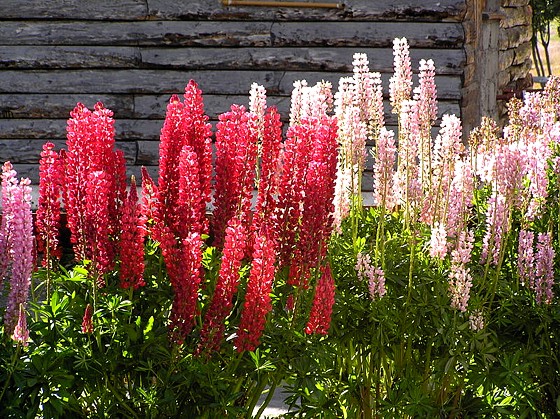
Garden cultivars of Lupinus polyphyllus
Lupinus polyphyllus (Large-leaved Lupine, Big-leaved Lupine, or, primarily in cultivation, Garden Lupin) is a species of lupine (lupin) native to western North America from southern Alaska and British Columbia east to Alberta and western Wyoming, and south to Utah and California. It commonly grows along streams and creeks, preferring moist habitats.
It is a perennial herbaceous plant with stout stems growing to 1.5 m tall. The leaves are palmately compound with (5-) 9-17 leaflets 3-15 cm long. The flowers are produced on a tall spike, each flower 1-1.5 cm long, most commonly blue to purple in wild plants.
There are five varieties:
Lupinus polyphyllus
var. burkei – Interior northwestern United States
Lupinus polyphyllus var. humicola – Interior western North
America
Lupinus polyphyllus var. pallidipes – Western Oregon and
Washington (Willamette Valley)
Lupinus polyphyllus var. polyphyllus – Coastal western North
America
Lupinus polyphyllus var. prunophilus – Interior western North
America
It is commonly used in gardens for its flowers; numerous cultivars have been selected for differing flower color, including red, pink, white, blue, and multicolored with different colors on different petals. Often hybrids between L. polyphyllus and L. arboreus are used, and sold under the name Rainbow Lupin. They are very hardy and can easily become invasive and hard to get rid of.
Low alkaloidal or sweet cultivars of this lupin suitable for fodder crops have been bred. To avoid restoration of alkaloid synthesis in cross-pollinated species of lupin, a new approach has been developed on the basis of specific crossing. Only compatible forms are involved in hybridization, with their low alkaloid content controlled by one and the same genetic system. These approaches have allowed transforming this bitter weed into a valuable fodder crop. In the conditions of Northwest Russia positive results from the use of the sweet commercial cultivar 'Pervenec' (first sweet variety), which is included in the State Catalogue of selection achievements of Russia. Breeding of sweet lupin is carried out also in Finland.
